January 12, 2024, marks the 50th anniversary of the Chicago Women in Architecture (CWA). In recognition, CHM curator of religion and community history Rebekah Coffman talks about the organization’s history and shares related items in our collection.
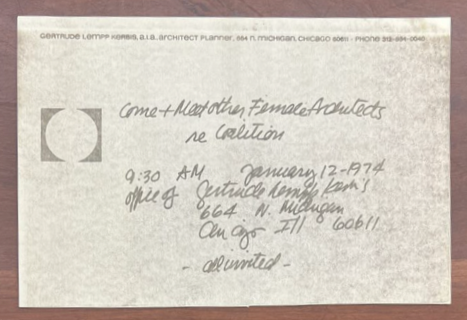
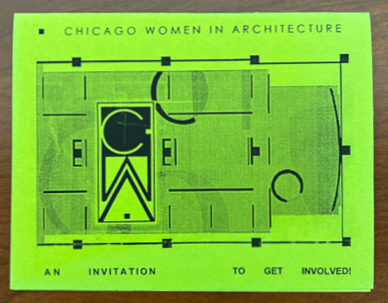
Chicago Women in Architecture invitations, including a reproduction of an original invitation by Gertrude Lempp Kerbis. CHM collection, Chicago Women in Architecture Records
Founded in 1974, CWA began with an inaugural meeting called by Gertrude Lempp Kerbis, in which women architects around the city were invited to discuss how to best mutually support one another in the male-dominated architectural field. Additional founding members include Nancy Abshire, Pao-Chi Chang, Gunduz Dagdelen Ast, Natalie de Blois, Laura Fisher, Jane M. Jacobsen, Barbara Ralph, Carol Ross Barney, Pu Hu Shao, Cynthia Weese, and Margaret Zirkel Young.
Just before this founding meeting, in December 1973, Wilbert R. Hasbrouck of the American Institute of Architects (AIA) Chicago wrote to Gertrude about the state of the AIA Chicago chapter, noting only twelve of its registered members were women. Meanwhile, AIA member directories around this time show roughly 700 total members listed in the Chicago area. This seemingly aligns with then-contemporary national trends, where gender representational disparities abounded. In 1957, at the centenary of the AIA’s founding, only 1% of registered national members were women. By 1982, almost a decade after the CWA’s founding, that figure had risen only slightly to 5%. The CWA’s call to action was timely in bringing these imbalances into focus through solidarity, advocacy, networking, mentorship, and increasing visibility for women in architecture and related fields, and its membership quickly jumped from its founding 12 to 40 in its first year.
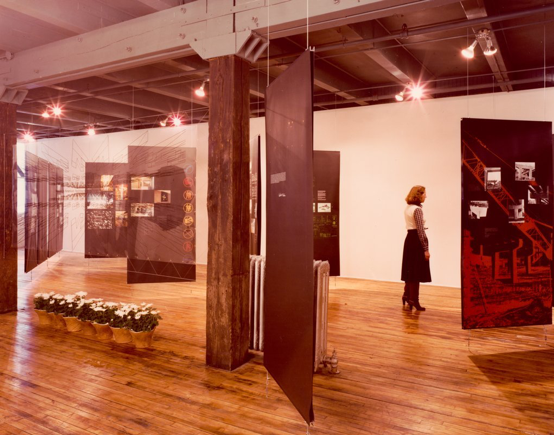
Chicago Women in Architecture: Contemporary Directions exhibition at the Artemisia Gallery, Chicago, 1978. CHM, ICHi-182682
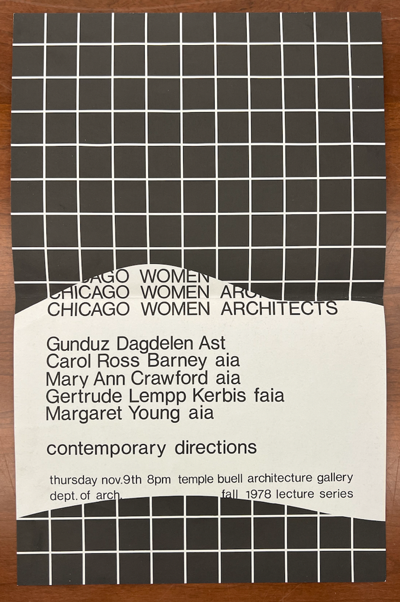
Promotional poster for Contemporary Directions, 1978, CHM collection, Chicago Women in Architecture Records
Just a few years after its founding, the CWA hosted an exhibition at the Artemisia Gallery in 1978 entitled Chicago Women Architects: Contemporary Directions. As the first group exhibition of women architects working in Chicago, it centered projects designed and built by women through panels with drawings and photographs. Represented projects in the catalogue included River Plaza with Margaret Young as project architect (1977), the Marie Sklodowska Curie High School with Po Hu Shao as project architect/designer (1973), University of Chicago Fieldhouse Alterations with Carol Ross Barney as project designer (1977), a corn crib in central Illinois by Cynthia Weese (1977), The Greenhouse by Gertrude Lempp Kerbis FAIA (1975), and the Webster Condominiums by Gunduz Dagdelen Ast (1977), among others.
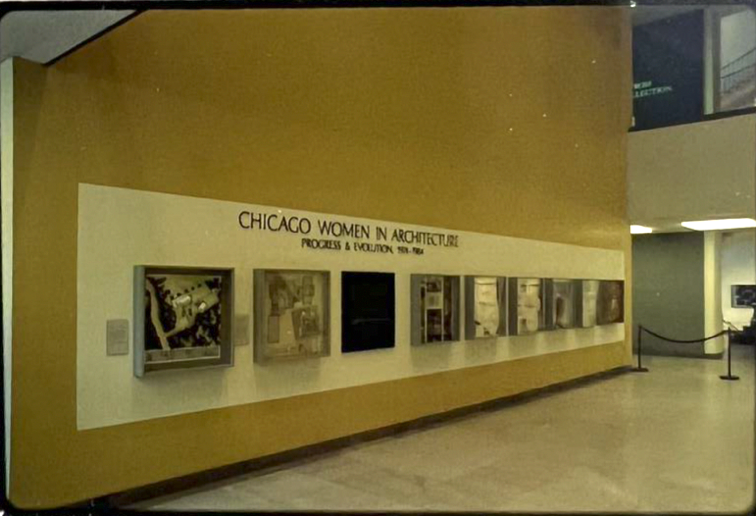
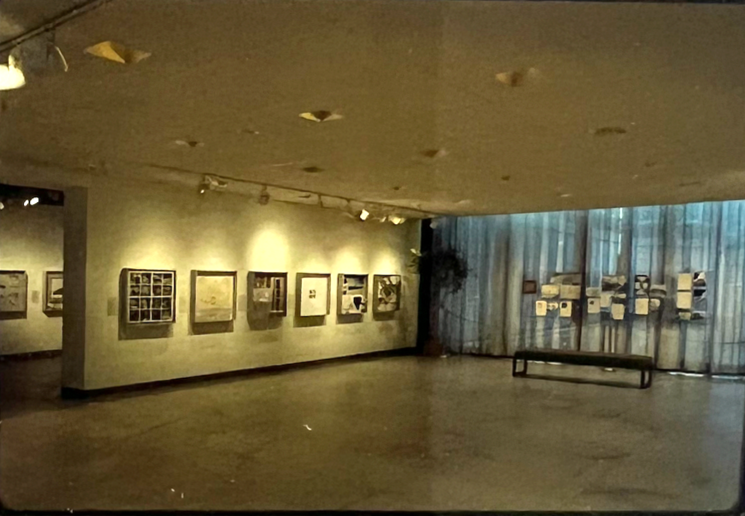
Installation views of Chicago Women in Architecture: Progress & Evolution, 1974–1984 at Chicago Historical Society. CHM collection
Six years later, to mark the 10th anniversary of CWA’s founding, the Chicago Historical Society (CHS, now the Chicago History Museum) exhibited Chicago Women in Architecture: Progress & Evolution 1974–1984. Opened October 20, 1984, the show featured the work of 54 women architects represented through a series of large shadowboxes.
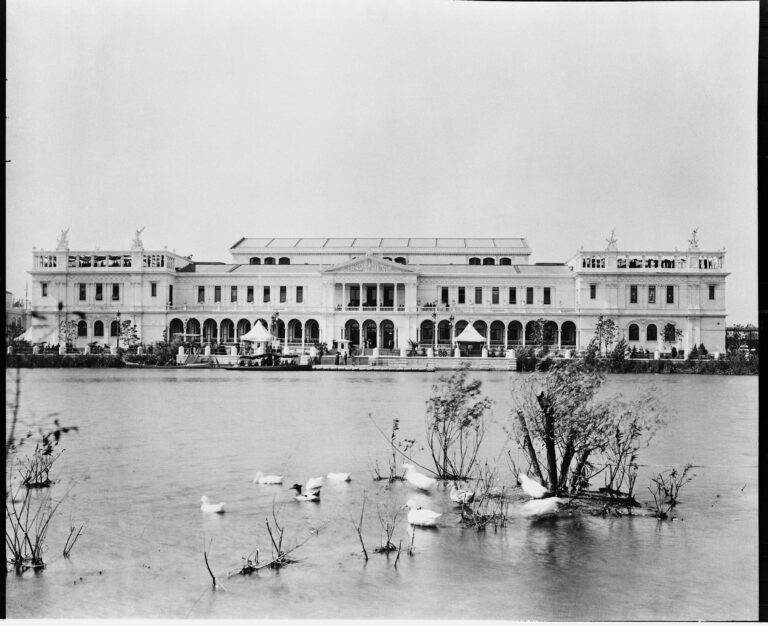
Exterior view of the Woman’s Building and lagoon at the World’s Columbian Exposition, 1893. CHM, ICHi-002302
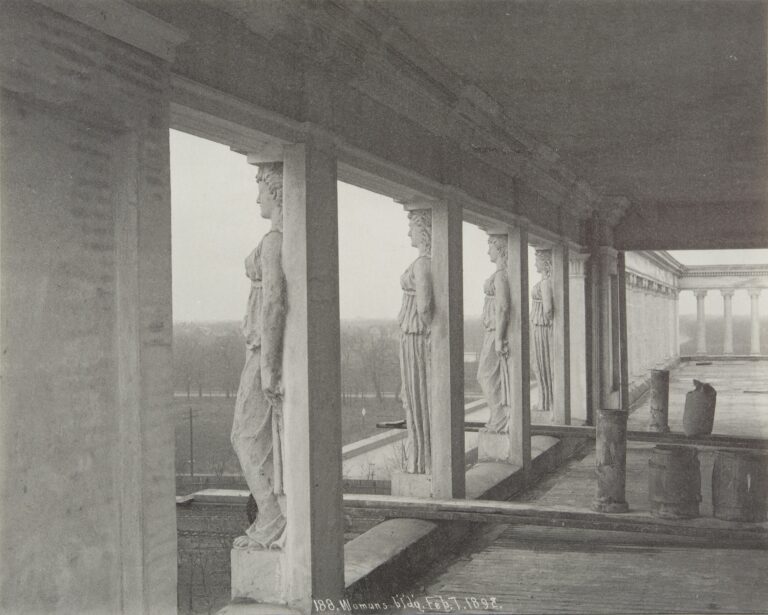
Woman’s Building under construction, showing caryatids sculpted by Enid Yandell. CHM, ICHi-059978
Sabra Clark, then Assistant Curator of the Architectural Collections at CHS, noted in the exhibition’s catalogue that the contributions of CWA stood on the shoulders of decades of women working and advocating for their place to define the built environment. The Woman’s Building at the 1893 World’s Columbian Exposition is cited as a key moment when an open competition for women architects led to Sophia Hayden’s winning design. The Woman’s Building itself became a motif used by the CWA in its membership drives, such as in a 1980 blueprint-inspired mailer.
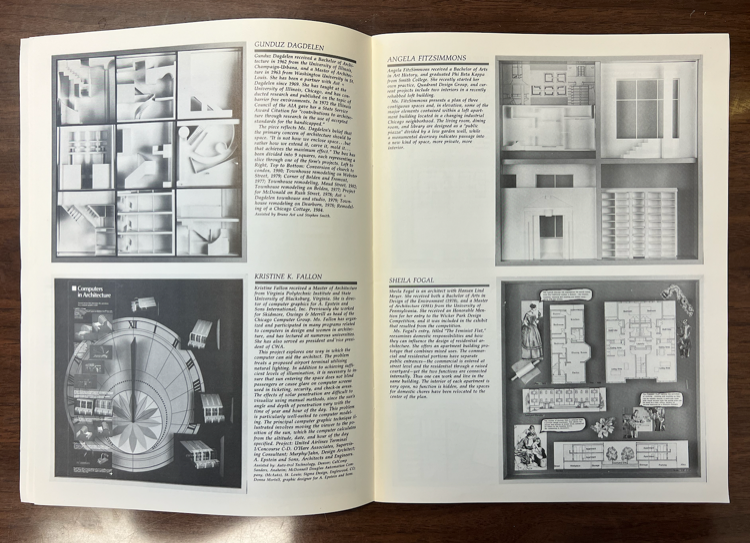
Pages from Chicago Women in Architecture: Progress & Evolution, 1974–1984 exhibition catalogue, featuring shadowbox designs, including by Gunduz Dagdelen Ast and Sheila Fogal. CHM collection, NA1997.C5 1984 OVERSIZE
The shadowboxes displayed in Progress & Evolution shifted away from exclusively literal representations of built and designed works, as were featured in Contemporary Directions, and instead allowed for thematic, abstracted, and recontextualized representations of projects, modes of practice, and ways of being as women architects. For example, Gunduz Dagdelen Ast, partner with Ast + Dagdelen and founding CWA member, contributed a box divided into nine squares that represents sections of nine different projects done by her firm. The exhibition catalogue quotes Dagdelen, saying, “It is not how we enclose space . . . but rather how we extend it, carve it, mold it . . . that achieves the maximum effect.” An example of this space-conscious design practice represented in the shadowbox includes Ast + Dagdelen’s clever adaptive reuse of a former Old Town church into residential spaces (square at top row, left).
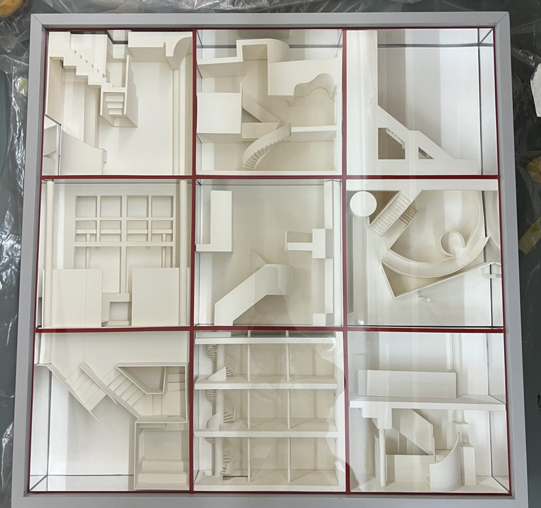
Shadowbox designed by Gunduz Dagdelen Ast. CHM collection. Photograph by Rebekah Coffman.
In another, Sheila Fogel’s piece, “The Feminist Flat,” considers gendered tasks and their influence in domestic design, noting the “traditional woman’s domain” are generally spaces “hidden away—along with the woman.” Her proposed “Feminist Flat” redesign locates the kitchen and laundry facilities centrally in the living spaces, presuming the shared visual/mental load would translate into shared domestic workload. In Fogel’s vision, flats of this arrangement would find a place in mixed-use residential apartment blocks, where “no commuting is necessary” between domestic and commercial life, a still sought-after urban ideal in today’s climate-conscious landscape.
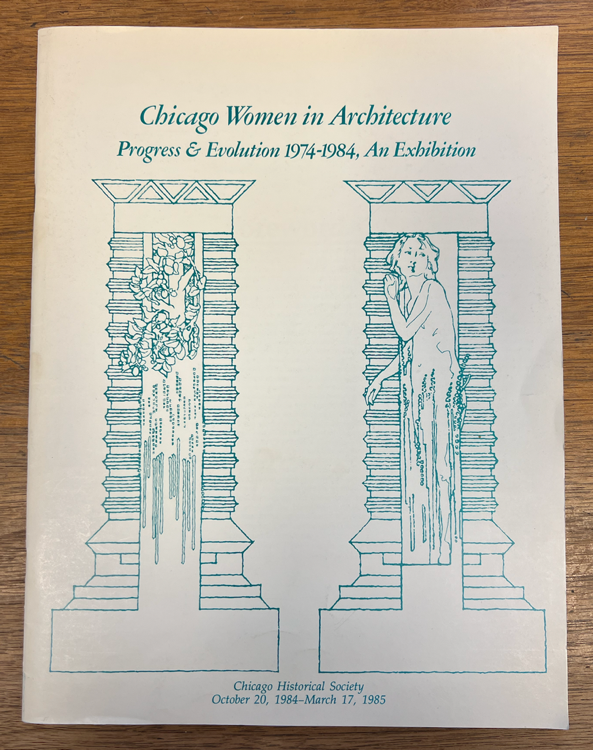
Chicago Women in Architecture: Progress & Evolution, 1974–1984; An Exhibition. CHM collection, NA1997.C5 1984 OVERSIZE
The Progress & Evolution exhibition catalogue’s cover features a reproduction of Chicago-born architect Marion Mahony Griffin’s (1871–1961) delineation of a pier design for the Cafe Australia, 1914. The pier to the right featuring the figure of a woman is a play on a popular architectural motif: the caryatid. Coming from ancient Greece, the sculpted image of a woman acted as a pillar, keeping the roof supported by the very strength of her form as a mark of eternal punishment by the gods. This has proven to be a powerful and multilayered metaphor for women working in and around the architectural field.
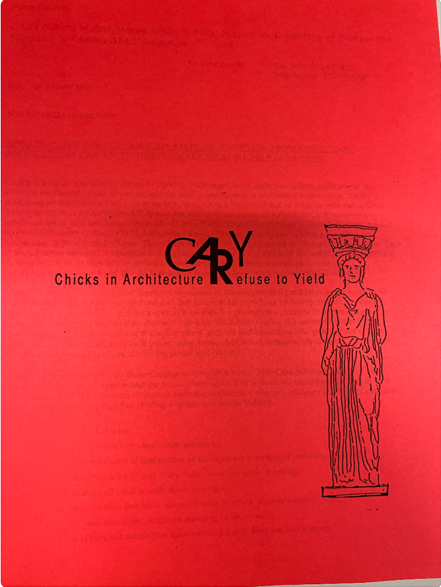
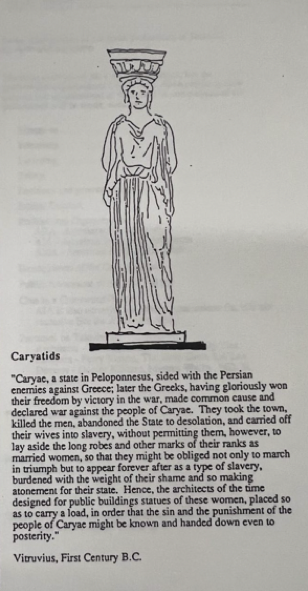
Chicks in Architecture Refuse to Yield (CARY) exhibition materials, CHM collection, Chicago Women in Architecture Records
For example, Chicks in Architecture Refuse to Yield to Atavistic Thinking in Design and Society (CARYATIDS), sometimes going by just CARY, was a Chicago-based design collective founded in 1992. CARY borrowed the female-pillar form to dismantle the status quo of the architectural “boys’ club” atmosphere of the field. Cofounders Carol J. Crandall, Kay Janis, and Sally Levine designed their 1993 exhibition more than the sum of our body parts at the Randall Street Gallery to address themes of gender-based discrimination through multimedia sculptural installations.
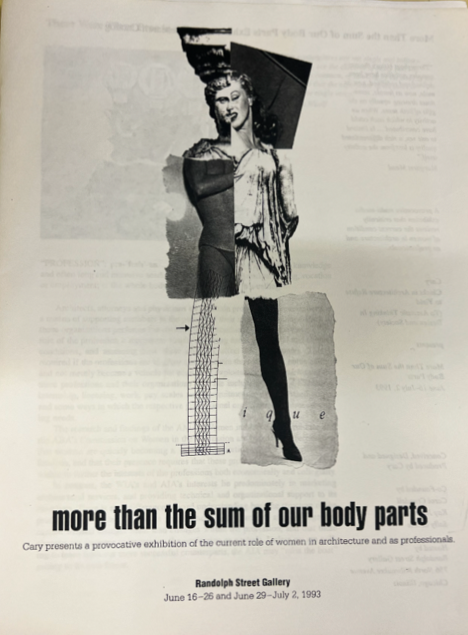
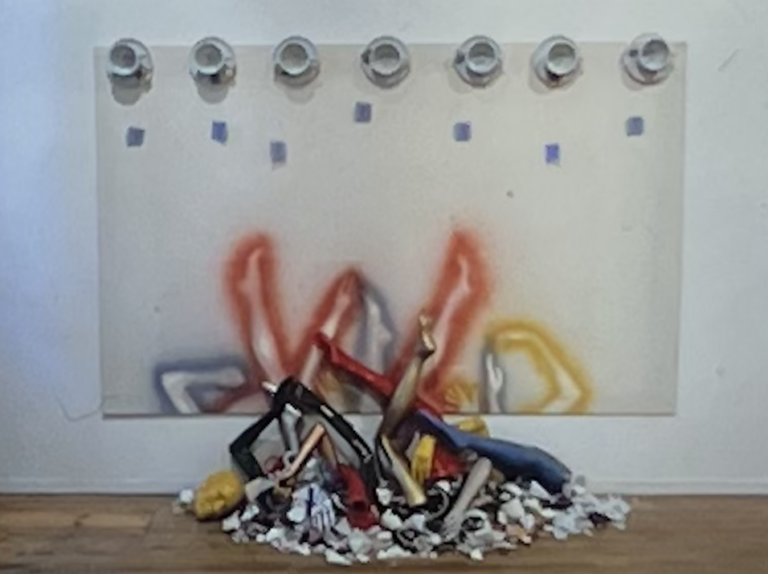
Exhibition catalogue for more than the sum of our body parts, cover and installation image for “Tea and Sympathy,” Chicks in Architecture Refuse to Yield, 1993. CHM collection, Chicago Women in Architecture Records
Installations were designed to address specific issues women faced in the field through metaphoric vignettes, including professional treatment, pay inequity, lack of female mentorship, lack of higher-level positions held by women, family issues, discrimination and harassment, and the myth of the single great architect creating alone. These provocative installations were a call to solidarity and an overt expression of some of the issues CWA organized around two decades prior. The caryatid metaphor and imagery persist today, for example, in the popular She Builds Podcast, which features women of the design and construction industry through podcasts and an online archive.
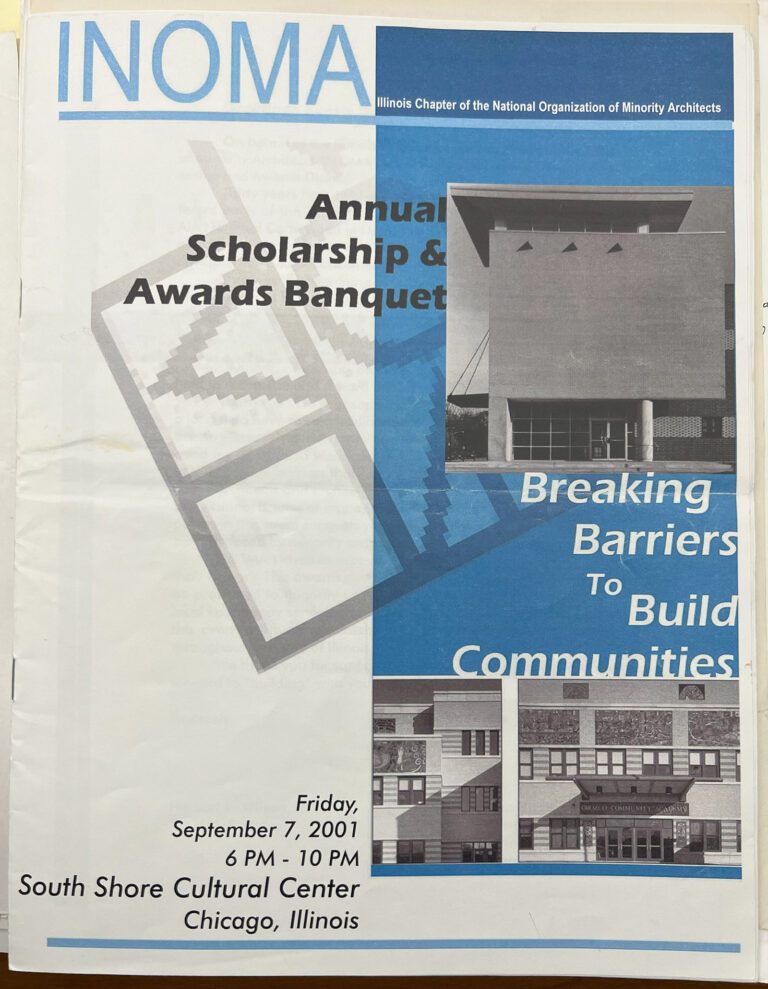
Cover of program for the Illinois Chapter of the National Organization of Minority Architects (INOMA) Annual Scholarship and Awards Banquet, September 7, 2001, with Susan J. Van Der Meulen of CWA as volunteer judge. CHM collection, Chicago Women in Architecture Records
In 2022, the number of AIA registered architects who identified as women rose to 24.9%, showing the impact gender advocacy by collectives like CWA and CARY have had on the profession. However, as continued strides are made toward gender equity in architecture, issues of discrimination and lack of representation persist across intersectional issues of race, ethnicity, and class. CWA archives hold past examples of collaboration and solidarity with organizations such as the Illinois Chapter of the National Organization of Minority Architects (INOMA), including efforts toward creating a Diversity Alliance to bring awareness to contributions to the built environment by women and minority architects.
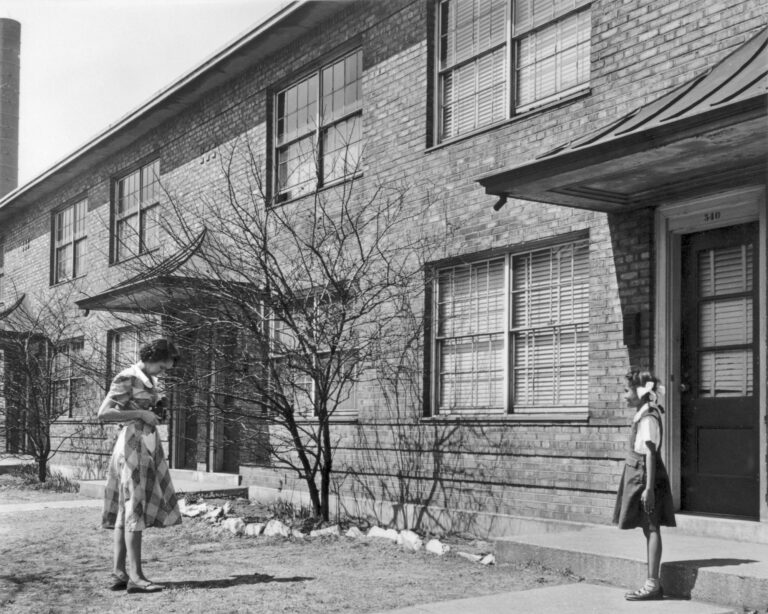
Tenants stand outside the Ida B. Wells Homes, 454 E. 39th St., Chicago, 1951. Beverly Lorraine Greene provided design contributions to the project as part of an architectural collaborative for the Chicago Housing Authority. CHM, ICHi-023374; Mildred Mead, photographer
Intersectional advocacy toward representational fairness is of critical importance in a field that remains predominantly white. For example, FIRST 500 founded by Chicago-based architect Tiara Hughes in 2018, notes Black women make up ~0.3% of all licensed architects. Beginning with the first Black woman to be registered as an architect in the United States, Chicago-born Beverly Lorraine Greene, FIRST 500 serves as a platform for not only bringing awareness to Black women’s contributions to the field but empowering future architects through mentorship. The legacy of coalitions like CWA can be celebrated in the call to build networks of solidarity and continue to work toward equity in the architecture field and beyond.
Additional Resources
- Chicago Women in Architecture Newsletter
- The Muse
- A Creative Constellation: Chicago Women in Architecture Celebrating 25 Years
- Chicago Women in Architecture Manuscript Materials
- Chicago Women Architects: Contemporary Directions
- Chicago Women in Architecture: Progress and Evolution 1974–1984
- People + Places: The Work of Carol Ross Barney
- Women Building Chicago, 1790–1990